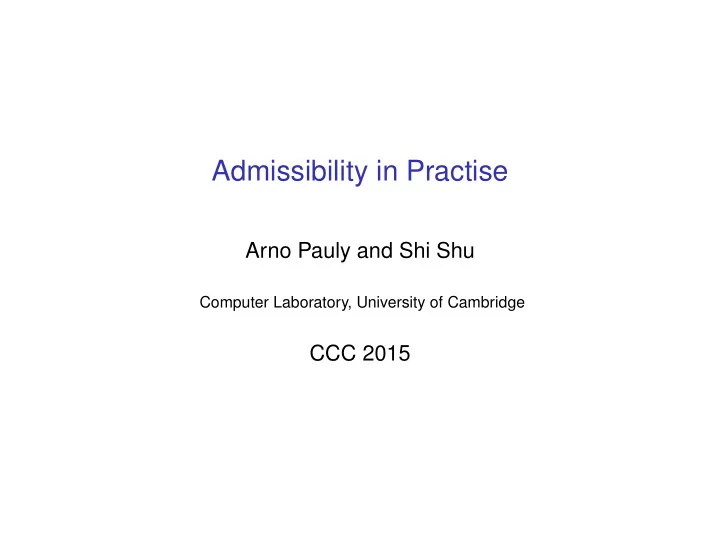

Admissibility in Practise Arno Pauly and Shi Shu Computer Laboratory, University of Cambridge CCC 2015
What is admissibility about? ◮ Common idea: Admissibility is (just) the criterion for which representations are correct. ◮ This is not true: e.g. ordinals, spaces from Descriptive Set Theory ◮ And admissibility is more than that.
Another idea ◮ Common idea: Topology is the fundament for computability on spaces of cardinality c ◮ This is not entirely true, as above ◮ But even more: Topology is a natural consequence of computability theory, not a prerequisite
Defining continuity Definition Continuity is computability relative to an arbitrary oracle. ◮ The UTM-theorem gives us function spaces C ( − , − ) ◮ together with Sierpinski space S = ( {⊤ , ⊥} , δ S ) where δ S ( p ) = ⊥ iff p = 0 N ◮ we get a notion of open sets O ( X ) ∼ = C ( X , S ) . ◮ the preimage of open sets under continuous functions is open – ◮ but the converse fails in general.
Defining admissibility following Schröder Definition We call X admissible, if the canonic map κ X : X → C ( C ( X , S ) , S ) is computable invertible. Note: Admissibility has algorithmic content! Theorem For functions with admissible codomain, (realizer) continuity and topological continuity coincide.
Closed and compact sets Definition A set is called closed, if its complement is open: Thus A ( X ) ∼ = O ( X ) . Definition We define the compact sets K ( X ) by identifying A ⊆ X with { U ∈ O ( X ) | A ⊆ U } ∈ O ( O ( X )) . ◮ ∩ : A ( X ) × K ( X ) → K ( X ) is computable. ◮ X is admissible, iff { x } �→ x : ⊆ K ( X ) → X is well-defined and computable.
Using admissibility 1. Conclude that the solution set S is closed based on its definition (this often involves the Hausdorff condition). 2. Obtain some compact candidate set K (either from the situation, or by assumption - this often involves some bounds). 3. Compute S ∩ K as a compact set 4. Use domain-specific reasoning or assumption to conclude that the solution s is unique. 5. As we have { s } available as a compact set, if our target space is admissible, we can compute s .
What we implemented in ML ◮ Exact reals with conversion to and from floating points. ◮ Addition and multiplication of reals. ◮ Sierpinski space, binary ∧ and ∨ , countable � ◮ isNotEqual and isPositive ◮ O ( − ) , A ( − ) , K ( − ) with the suitable operations ◮ [ − 1 , 1 ] ∈ K ( R ) ◮ { x } �→ x : ⊆ K ( R ) → R
Compactness ◮ [ − 1 , 1 ] ∈ K ( R ) is realized by some function c : C ( R , S ) → S ◮ We can only evaluate the input function on "points". ◮ Trick: Use disguised reals such as . − 1 0 DoNotLook ◮ Start with list . DoNotLook and evaluate input on all points. If a point gets accepted, remove it. If the exception gets raised, add all "successor points" to the list. If the list ever gets empty, accept the input function.
Admissibility ◮ Every real in ( n − 1 , n + 1 ) has a name with n before the digit: So search for an open interval covering the compact singleton. ◮ Then submit the resulting interval in ( n − 1 , n ) , ( n − 0 . 5 , n + 0 . 5 ) , ( n , n + 1 ) and search for one covering the compact singleton to determine the next digit, etc.
What we used it for ◮ We can define x �→ 0 . 5 x : [ − 2 , 2 ] → [ − 1 , 1 ] by letting 0 . 5 x be the unique y ∈ [ − 1 , 1 ] such that Y + y = x . ◮ Unfortunately, this currently takes about 2 minutes to compute 4 digits. . . ◮ Maybe some hopes for optimization and use for problems where numerical algorithms are not yet available.
The sources S. Shu. An Exact Real Package in ML. Part II Project, University of Cambridge, 2015. A. Pauly. On the topological aspects of the theory of represented spaces. Computability (accepted for publication, cf arXiv:1204.3763).
Further reading M. Schröder. Admissible Representations for Continuous Computations. PhD Thesis, FernUniversität Hagen, 2002. A. Bauer. Sometimes all functions are continuous. http://math.andrej.com/2006/03/27/ sometimes-all-functions-are-continuous/ M. Escardó. Algorithmic solution of higher type equations. Journal of Logic and Computation, 2013.
Recommend
More recommend